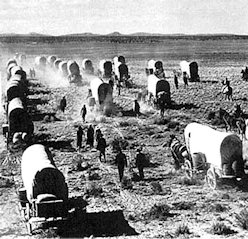
|
Some Common Myths Thought to be True - Myth 137
Myth 137: Pioneer Wagon Trains Traveled in a Straight Line
A much-beloved image of the Old West is that of wagon trains traveling in
straight, single-file lines across the prairies. Wagon trains, whenever
possible, traveled side-by-side, up to ten miles wide, to avoid the billowing
clouds of dust as well as the furrows, ruts, and potholes of previous
travelers. If they had in fact traveled single-file, every wagon behind the
lead would not only eat their dust, they would have also wear it and have it
clog their nostrils and cake over their eyes.
|
| Pioneer Wagon Trains | |
|
Perhaps the most famous wagon train trail was the Oregon Trail which had a span
of over 2,000 miles. Other paths included the Santa Fe Trail, the Chisholm
Trail, the California Trail (which split southwestward from the Oregon Trail),
the Mormon Trail, and the Old Spanish Trail.
|
|
| ⇦ Back to Myth 136 Return to Myth Choices Page 10 On to Myth 138 ⇨ | |